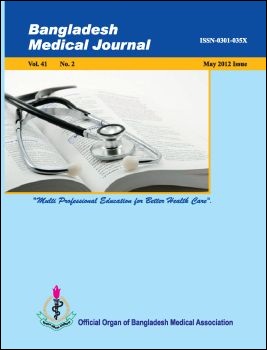Aetio-Clinical Profile of Cholestatic Jaundice During Infancy- Study of 30 Cases in a Tertiary Care Hospital
DOI:
https://doi.org/10.3329/bmj.v41i2.18804Keywords:
Cholestatic Jaundice, Biliary Atresia, Neonatal Hepatitis, InfancyAbstract
Cholestasis in young infants has a varied etiology. There is considerable delay in presentation of cholestatic cases, both in India (average delay of 3 months in referral centers) and Bangladesh (3.5 months). Early diagnosis is important as the effects of cholestasis are profound and wide-spread. EHBA comprises a significant proportion of cases of cholestatic diseases. If treatment of EHBA is delayed beyond the first 90 days of life, the only option thereafter is liver transplantation, which is not presently feasible on a large scale in developing countries. So, the aim and objective of this study is to determine the cause and to categorize the clinical profile and treatment options of conjugated hyperbilirubinaemia in infancy. A total of 30 patients, who fulfilled inclusion and exclusion criteria were included. A detailed history and physical examination was done daily. Complete blood count, liver function tests, HBsAg and TORCH screening, thyroid function test, Urine was tested for non-glucose reducing substances. Ultrasonography of the hepatobiliary system and hepatobiliary scintigraphy was done. Liver biopsy was done in appropriate patients. Patients were followed up daily during hospital stay. The management and its response were also monitored and recorded. Out of 30 patients 24 (80%) were male and 6 (20%) were female. 63% were term and 37% were preterm. Out of 12 patients in BA, 11 were term and only 1 was preterm, whereas in NH group, out of 18 babies, 10 were preterm. Most of the patients were male in both studied groups. Mean value of birth weight in BA was 2.65±0.13 and in NH was 2.40±0.31. Mean age (days) at onset of jaundice in 2 groups were 3.92 ± 2.43 in BA and 6.5 ±4.5 in NH. Most patients of BA (91%) had persistent acholic stool, whereas in Neonatal hepatitis group 83% had intermittent acholic stool. No statistically significant difference was observed when hepatosplenomegaly and ALT values were considered in 2 studied groups. In BA group 33% & In NH group 72% babies had positivity for CMV infection. Normal ultrasonic findings were seen in 2 patients of BA group, and 7 in NH group. No patient had shown contracted gall bladder after meal in BA, Choledocal cyst was found to be responsible for 5 (42%) patients in BA group and none in NH group. HIDA showed 47% had biliary atresia, 43% neonatal hepatitis and 10.0% had normal liver. Liver biopsy revealed that 12 (40.0%) had biliary atresia and 18 (60.0%) had neonatal hepatitis. Out of 12 babies in Biliary atresia group almost all, 11(92%) received surgical management where as in Neonatal hepatitis group; all 18 babies (100%) received medical treatments. Early detection of cholectatic cases by observing stool colour is very important for physicians to direct the very specific investigations to find out the cause and start appropriate treatment immediately.
DOI: http://dx.doi.org/10.3329/bmj.v41i2.18804
Bangladesh Medical Journal 2012 Vol. 41 No. 2: 34-39
Downloads
891
989

